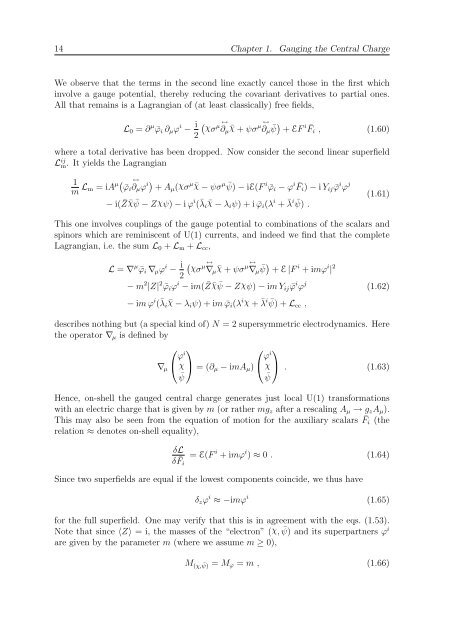N=2 Supersymmetric Gauge Theories with Nonpolynomial Interactions
N=2 Supersymmetric Gauge Theories with Nonpolynomial Interactions
N=2 Supersymmetric Gauge Theories with Nonpolynomial Interactions
Create successful ePaper yourself
Turn your PDF publications into a flip-book with our unique Google optimized e-Paper software.
14 Chapter 1. Gauging the Central Charge<br />
We observe that the terms in the second line exactly cancel those in the first which<br />
involve a gauge potential, thereby reducing the covariant derivatives to partial ones.<br />
All that remains is a Lagrangian of (at least classically) free fields,<br />
L0 = ∂ µ ¯ϕi ∂µϕ i − i ↔<br />
χσ<br />
µ<br />
∂µ<br />
2<br />
¯χ ↔<br />
µ<br />
+ ψσ ∂µ ¯ ψ + EF i Fi<br />
¯ , (1.60)<br />
where a total derivative has been dropped. Now consider the second linear superfield<br />
L ij m. It yields the Lagrangian<br />
1<br />
m Lm = iA µ ↔<br />
¯ϕi ∂µϕ i + Aµ(χσ µ ¯χ − ψσ µ ψ) ¯ i<br />
− iE(F ¯ϕi − ϕ i Fi) ¯ − i Yij ¯ϕ i ϕ j<br />
− i( ¯ Z ¯χ ψ¯ − Zχψ) − i ϕ i ( ¯ λi ¯χ − λiψ) + i ¯ϕi(λ i + ¯ λ i ψ) ¯ .<br />
(1.61)<br />
This one involves couplings of the gauge potential to combinations of the scalars and<br />
spinors which are reminiscent of U(1) currents, and indeed we find that the complete<br />
Lagrangian, i.e. the sum L0 + Lm + Lcc,<br />
L = ∇ µ ¯ϕi ∇µϕ i − i ↔<br />
χσ<br />
µ<br />
∇µ<br />
2<br />
¯χ ↔<br />
µ<br />
+ ψσ ∇µ ¯ ψ + E |F i + imϕ i | 2<br />
− m 2 |Z| 2 ¯ϕiϕ i − im( ¯ Z ¯χ ψ¯ − Zχψ) − im Yij ¯ϕ i ϕ j<br />
− im ϕ i ( ¯ λi ¯χ − λiψ) + im ¯ϕi(λ iχ + ¯ λ i ¯ ψ) + Lcc ,<br />
(1.62)<br />
describes nothing but (a special kind of) N = 2 supersymmetric electrodynamics. Here<br />
the operator ∇µ is defined by<br />
∇µ<br />
⎛<br />
ϕ<br />
⎝<br />
i<br />
⎞<br />
⎛<br />
ϕ<br />
χ ⎠ = (∂µ − imAµ) ⎝<br />
¯ψ<br />
i<br />
⎞<br />
χ ⎠ .<br />
¯ψ<br />
(1.63)<br />
Hence, on-shell the gauged central charge generates just local U(1) transformations<br />
<strong>with</strong> an electric charge that is given by m (or rather mgz after a rescaling Aµ → gzAµ).<br />
This may also be seen from the equation of motion for the auxiliary scalars ¯ Fi (the<br />
relation ≈ denotes on-shell equality),<br />
δL<br />
δ ¯ Fi<br />
= E(F i + imϕ i ) ≈ 0 . (1.64)<br />
Since two superfields are equal if the lowest components coincide, we thus have<br />
δzϕ i ≈ −imϕ i<br />
(1.65)<br />
for the full superfield. One may verify that this is in agreement <strong>with</strong> the eqs. (1.53).<br />
Note that since 〈Z〉 = i, the masses of the “electron” (χ, ¯ ψ) and its superpartners ϕ i<br />
are given by the parameter m (where we assume m ≥ 0),<br />
M (χ, ¯ ψ) = Mϕ = m , (1.66)

















